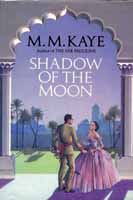Reviews for 'THE SHADOW OF THE MOON' (1957)
 Here are some newspaper reviews for The Shadow of the Moon dating from 1957, when the novel was originally published to celebrate the centenary of the Indian Mutiny. It is interesting to compare them with the reviews published 22 years later in 1979 when The Shadow of the Moon was republished following the enormous commercial and critical success of The Far Pavilions. The reviews are in no particular order.
Here are some newspaper reviews for The Shadow of the Moon dating from 1957, when the novel was originally published to celebrate the centenary of the Indian Mutiny. It is interesting to compare them with the reviews published 22 years later in 1979 when The Shadow of the Moon was republished following the enormous commercial and critical success of The Far Pavilions. The reviews are in no particular order.
The Daily Telegraph, 29 April 1957
Anglo-Indian Novel
MISS MOLLY KAYE, the author of ‘Shadow of the Moon,’ a new novel on the Indian Mutiny is well qualified to write on the subject. She was born in India and has lived most of her life there.
The book’s dedication shows her credentials. Miss Kaye names five members of her family who lived and worked in India, including Sir John William Kaye, the official historical of the Mutiny.
Her husband, Col. Goff Hamilton, is Chief of Staff to the G.O.C. Northern Ireland District. He was in the Guides but transferred to the Royal Irish Fusilliers in 1947.
Miss Kaye tells me that although she used Sir John Kaye’s history in which he speaks not of “the Mutiny” but of “the Sepoy War in Inndia,” it was not her prime source.
That was the 18 volumes of the Mutiny trials – a sort of Hansard of the proceedings.
Yorkshire Evening News, 11 April 1957
Mutiny days
Mrs Molly Kaye paints a gay and tragic picture of India at the time of the mutiny a hundred years ago in Shadow of the Moon (Longman, Green 18s).
Having lived in India as the wife of a soldier, Mrs Kaye has spared no effort to get the right setting for a story which depicts vividly the life of the British colonials.
The story concerns Alex a shrewd assistant commissioner and Winter, the fiancée of Alex’s superior. Life in the days prior to the mutiny was an uncaring, social whirl through which flit many intriguing characters.
Then came the uprising with its bloody massacres and pointless slaughter. Alex and Winter find themselves thrown together in the ever-dangerous jungle. And so almost unwillingly they go on to find a solution to their problems. D.A.H
Cape Argus – Cape Town, 27th June 1957
Indian Mutiny tale
Shadow of hte Moon by M. M. Kaye (Longman)
This big novel (632 pages) is set to the background of the Indian Mutiny. It has plenty of excitement and some good writing. Geographical and historical colour are authentic, for Miss Kaye knows India well and is closely acquainted with its past.
East African Standard 24th May 1957
A picture of India in the shadow of the moon by J Humprhies
There are literally dozens and dozens of new novels in the shops at the moment and it is by no means easy to make a selection for review. I have tried this week, therefore, to find as much contrast as possible in the titles.
Shadow of the Moon BY Miss M. M. Kaye is already fairly well known and it looks like setting down into being one of the year’s favourites. It is a huge sprawling, picturesque and highly romantic picture of India at the time of the Mutiny, the centenary of which is being remembered this year.
Church of England Newspaper, 7th June 1957
We come now to some English novels. Shadow of the Moon is a story of the Indian Mutiny for which the author is well-equipped with her knowledge of India and her Army background. She gives very well the richness and colour of India, its climate and its people, the growing tension of the time, the deadly effect of our unimaginative over-confidence. Interlocked is a conventionally romantic story of a young girl sent from England to marry a man in ignorance of his real nature. She arrives shortly before the Mutiny and is involved in all its horrors. It is a very readable book and should be widely popular.
Star, 11th April 1957
SHADOW OF THE MOON (Longmans, 18s) by M. M. Kaye. A long and very frankly descriptive novel about the Indian Mutiny. The picture of the gay life of the colonels and their ladies before the blow fell particularly well done.
Times Literary Supplement, 19th April 1957
Shadow of the Moon is an unbiased picture of India at the time of the Mutiny emphasizing that not only the policy of the Company but in addition the personal failings of many of its servants gave the sepoys of the Bengal Army an excuse for betraying their allegiance. The events of the war are clearly described, and the author makes the point that British garrisons in every station were hampered by the presence of women and children, who must be protected even if their protection immobilized a possible striking force But perhaps this book would have been better as a popular history of the Mutiny for the fictitious characters are wooden and unconvincing.
The Spectator, 12th April 1957
Shadow of the Moon is an excellent, long historical novella about the Indian Mutiny, excellent be3cause Miss Kaye has a real historical conscience a sense of impartiality and a great many old mutiny records to draw upon. She cannot refrain from exploiting the amorous and horrific side of the business – dashing officers with moustaches, and screaming ladies in crinolines having their heads hacked off by sepoys – but she does not let these things get out of hand and she should be read by those interested in the period as well as by addicts of the romantic past. John Bayley
The Times, 11th April 1957
Miss Kaye’s novel, also about the Far East, is more conventional; an historidcal novel aqt its full-blooded best. The author’s family have long connections with India and Shadow of the Moon is a well-informed reconstruction of the Mutiny. Her account of it causes is thoughtful and well-balanced, the lessons for to-day brought home without distorting the narrative. Against those stirring and terrible happenings the love-story which forms a connecting thread is rather conventional and romanticised, but it serves as a change of mood, and a sugar for the unpalatable pill of historical warning.
Evening News, 13th April 1957
(first part is missing) This novel seems to me a distinguished discovery by the house of Longman; and it is a pleasant coincidence that its author is the great-niece of Sir John Kaye, who wrote one of the standard histories of the Mutiny. John Connell
Evening Standard, 9th April 1957
SHADOW OF THE MOON. By M. M. Kaye. Longmans 18s.
Mammoth historical novel (632 pages) about the Indian Mutiny. Heroine is raven-haried Winter de Balesteros, betrothed to the corrupt Commissioner of Lunjore, but in love with dashing Captain Alex Randall, and coveted by wicked Lord Carlyon. Tedious interludes of face-slapping and attempted rape, but grandly staged mutiny, with blood-lusting sepoys putting white India to the sword. Factually correct (information drawn from a forgotten set of Mutiny Trails) and told with tremendous vigour. Aimed for the Gone-with-the-Wind market. It could have the same runaway success. Philip Oakes.
New Statesman, 6th April 1957 by John Rayniery
Given this somewhat arbitrary and experimental distinction, we must all agree that there is no time like the present for the historical novel in all its variety and richness. For some curious reason – perhaps because, thought just as scholarly, they are less fettered to the ideals of pure pedantry – almost all the writers who have made their n ames in this genre since the war have been women. The roll-call of their achievements, in the last ten years, is extraordinary. Building firmly on the foundations of the Thirties – Mrs Naomi Mitchison’s Black Sparta, and The Conquered, Miss Rose Macaulay’s They Were Defeated – they have raised a succession of enduring works of art. Some, like Mrs Charque’s weird and enthrallilng The Dark Stranger or Bryher’s new study of the Jacobean theatre are finely woven Gobelins, too tapestried and finished for my taste, but wonderfully evocative nonetheless. Others, such as M. M. Kaye’s saga of the Indian Mutiny, display a fine range and solidity of treatment without ever quite reaching the height of the historical argument. (Miss Kaye’s book is an extravagantly rich and even bizarre achievement, a kind of English upper-middle-class Gone with the Wind, written with a smooth and even gentility that at times almost disguises the writer’s gifts as a story-teller; the two books repay comparison.)
